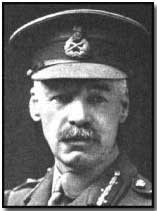Who's Who - Sir Henry Rawlinson
 Sir Henry Rawlinson (1864-1925) was
born in 1864, the son of a diplomat. Having joined the British Army he
served in the Myanmar expedition of 1886-87 under Lord Roberts, in the Sudan campaign (1898)
with Lord Kitchener (minister for war during the First World War
from 1914-16),
and in the Second Boer War (1899-1901).
Sir Henry Rawlinson (1864-1925) was
born in 1864, the son of a diplomat. Having joined the British Army he
served in the Myanmar expedition of 1886-87 under Lord Roberts, in the Sudan campaign (1898)
with Lord Kitchener (minister for war during the First World War
from 1914-16),
and in the Second Boer War (1899-1901).
When war broke out in August 1914 Rawlinson was given command of IV Corps sent to assist the Belgian Army against the German siege of Antwerp. In 1916 he was appointed Lieutenant General of Fourth Army, playing a primary role in the Battle of the Somme of July-November 1916, where his arguments for a limited infantry offensive contrasted markedly (and ultimately disastrously) with Sir Douglas Haig's breakthrough plans. Notwithstanding the Somme fiasco Rawlinson is generally regarded today as a highly competent field commander.
Aside from representing Britain on the Supreme War Council from February 1918, Rawlinson's Fourth Army achieved notable success in breaking through the German line between St. Quentin and Cambrai later that year in August 1918.
Following the armistice, in 1919, Rawlinson was raised to the peerage. That same year he was dispatched to Russia as commander of the allied forces sent to attempt to overthrow the Bolshevik government. In 1920 he was sent to command the British forces in India, a position he held until his death.
Sir Henry Rawlinson died in 1925.
The "Red Baron" was the allied nickname for German air ace Manfred von Richthofen, the leading ace of the war.
- Did you know?
